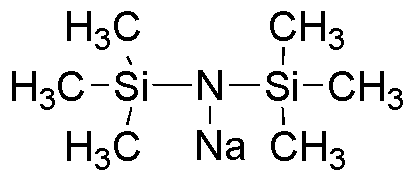Sodium bis(trimethylsilyl)amide solution, 1.0 M in THF is widely utilized in research focused on:
- Organic Synthesis: This compound serves as a strong base and nucleophile, making it ideal for deprotonation reactions and the synthesis of various organic compounds, particularly in the creation of complex molecules in pharmaceuticals.
- Metalation Reactions: It is commonly used in metalation processes, where it helps in the introduction of metal centers into organic frameworks, enhancing the catalytic properties of compounds in materials science.
- Silicon Chemistry: The compound plays a crucial role in silicon-based chemistry, facilitating the formation of silanes and siloxanes, which are important in the production of silicone materials used in sealants and adhesives.
- Polymer Chemistry: It is utilized in the synthesis of novel polymers, particularly those that require specific functional groups, enabling the development of advanced materials with tailored properties for applications in coatings and electronics.
- Research in Catalysis: This solution is a key reagent in the development of new catalytic systems, providing researchers with the ability to explore innovative pathways for chemical transformations, thus improving efficiency and selectivity in reactions.
Información general
Propiedades
Seguridad y normativas
Aplicaciones
Sodium bis(trimethylsilyl)amide solution, 1.0 M in THF is widely utilized in research focused on:
- Organic Synthesis: This compound serves as a strong base and nucleophile, making it ideal for deprotonation reactions and the synthesis of various organic compounds, particularly in the creation of complex molecules in pharmaceuticals.
- Metalation Reactions: It is commonly used in metalation processes, where it helps in the introduction of metal centers into organic frameworks, enhancing the catalytic properties of compounds in materials science.
- Silicon Chemistry: The compound plays a crucial role in silicon-based chemistry, facilitating the formation of silanes and siloxanes, which are important in the production of silicone materials used in sealants and adhesives.
- Polymer Chemistry: It is utilized in the synthesis of novel polymers, particularly those that require specific functional groups, enabling the development of advanced materials with tailored properties for applications in coatings and electronics.
- Research in Catalysis: This solution is a key reagent in the development of new catalytic systems, providing researchers with the ability to explore innovative pathways for chemical transformations, thus improving efficiency and selectivity in reactions.
Documentos
Hojas de datos de seguridad (HDS)
La SDS proporciona información de seguridad completa sobre la manipulación, el almacenamiento y la eliminación del producto.
Especificación del producto (PS)
La PS proporciona un desglose completo de las propiedades del producto, incluida la composición química, el estado físico, la pureza y los requisitos de almacenamiento. También detalla los rangos de calidad aceptables y las aplicaciones previstas del producto.
Certificados de análisis (COA)
Busque certificados de análisis (COA) ingresando el número de lote del producto. Los números de lote y de partida se pueden encontrar en la etiqueta de un producto después de las palabras "Lote" o "Lote".
Número de catálogo
Número de lote/lote
Certificados de origen (COO)
Este certificado de origen confirma el país en el que se fabricó el producto y también detalla los materiales y componentes utilizados en él y si se deriva de fuentes naturales, sintéticas u otras fuentes específicas. Este certificado puede ser necesario para cumplir con las normativas aduaneras, comerciales y regulatorias.
Número de catálogo
Número de lote/lote
Hojas de datos de seguridad (HDS)
La SDS proporciona información de seguridad completa sobre la manipulación, el almacenamiento y la eliminación del producto.
DownloadEspecificación del producto (PS)
La PS proporciona un desglose completo de las propiedades del producto, incluida la composición química, el estado físico, la pureza y los requisitos de almacenamiento. También detalla los rangos de calidad aceptables y las aplicaciones previstas del producto.
DownloadCertificados de análisis (COA)
Busque certificados de análisis (COA) ingresando el número de lote del producto. Los números de lote y de partida se pueden encontrar en la etiqueta de un producto después de las palabras "Lote" o "Lote".
Número de catálogo
Número de lote/lote
Certificados de origen (COO)
Este certificado de origen confirma el país en el que se fabricó el producto y también detalla los materiales y componentes utilizados en él y si se deriva de fuentes naturales, sintéticas u otras fuentes específicas. Este certificado puede ser necesario para cumplir con las normativas aduaneras, comerciales y regulatorias.

